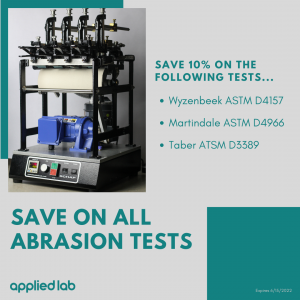Applied Lab offers three abrasions tests. Textile abrasion tests are used to predict how well a fabric will uphold once it is upholstered for use. What test you use will depend on the end-use of your materials.
Wyzenbeek, Martindale, and Taber are all versions of abrasion testing for textiles, but how do they differ? With the Wyzenbeek ASTM D4157 test, the fabric is cut from the warp and weft direction and placed face to face with a wire duck or screen, and subjected to a back and forth rubbing motion. The number of double rubs completed before the fabric shows noticeable wear will be recorded as the fabric’s abrasion rating.
Martindale ASTM D4966 is an oscillating abrasion test. Fabric is mounted flat and rubbed in a Lissajous figure movement, similar to a figure 8, against a piece of worsted wool cloth. The number of cycles completed before fabric shows noticeable wear will determine the abrasion rate.
Lastly, the Taber ASTM D3389 test will determine the abrasion resistance of a coated fabric. The fabric is mounted flat, such as with the Martindale test. A weighted abrader wheel is lowered to touch the surface of the fabric; the abrader wheel and fabric then spin at a fixed speed while rubbing together. After a specific number of cycles, the fabric will be checked and rated for any wear caused by the abrader wheel.
Applied Lab is currently offering promotions on all abrasion testing. Save 10% on Wyzenbeek, Martindale, and Taber abrasion resistance testing.

To learn more about abrasion testing please contact 616-559-6123 or contact@applied-lab.com